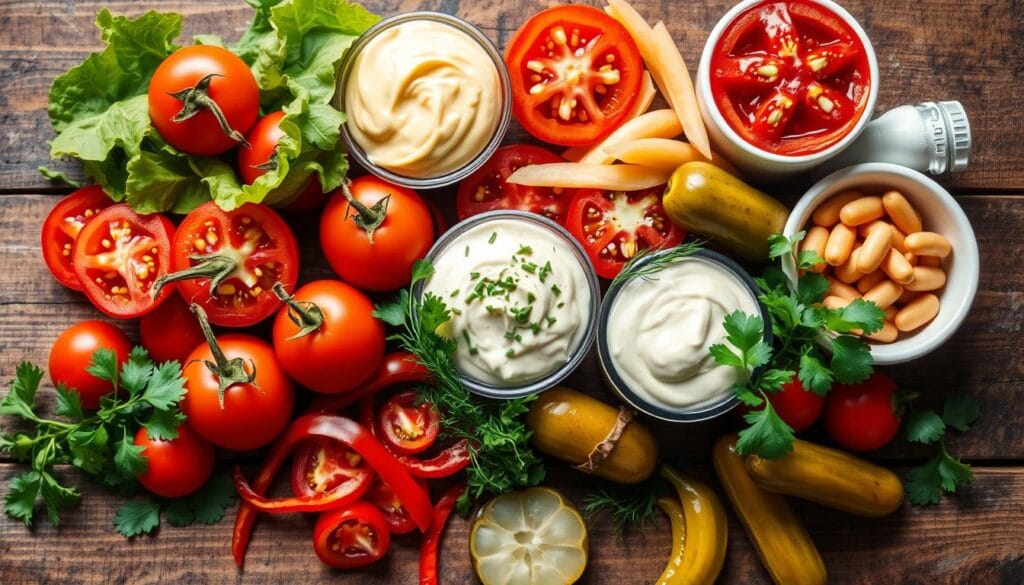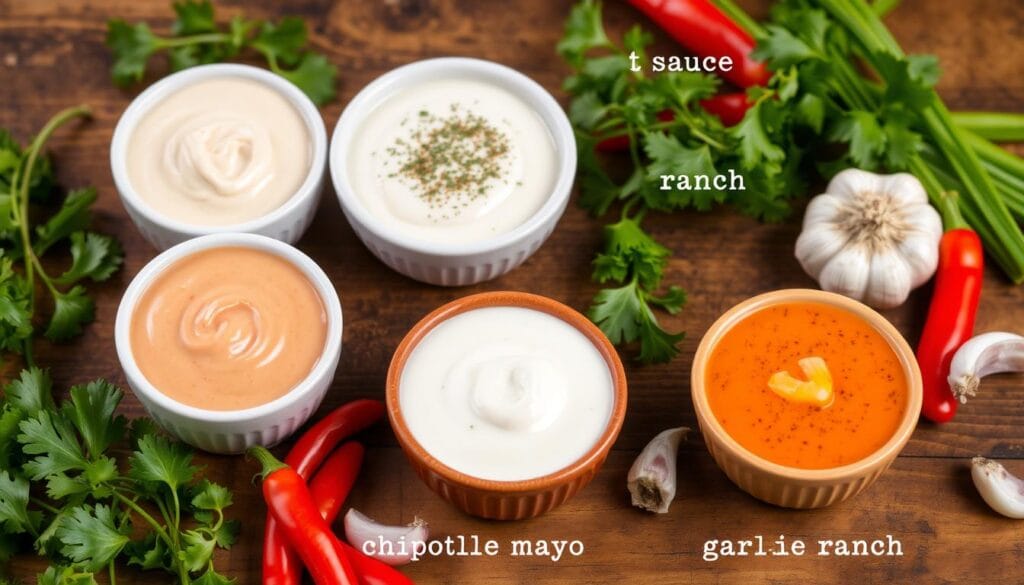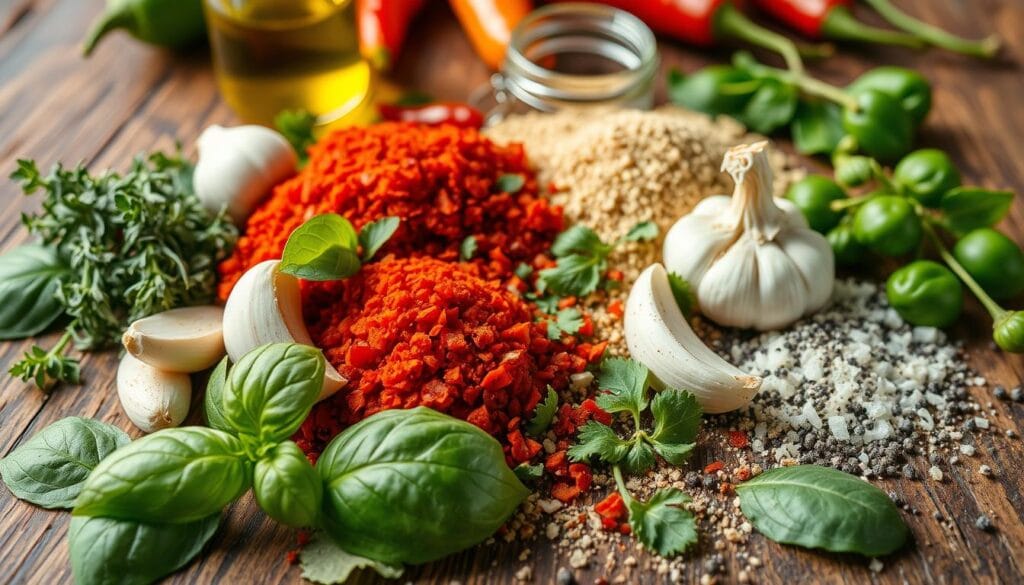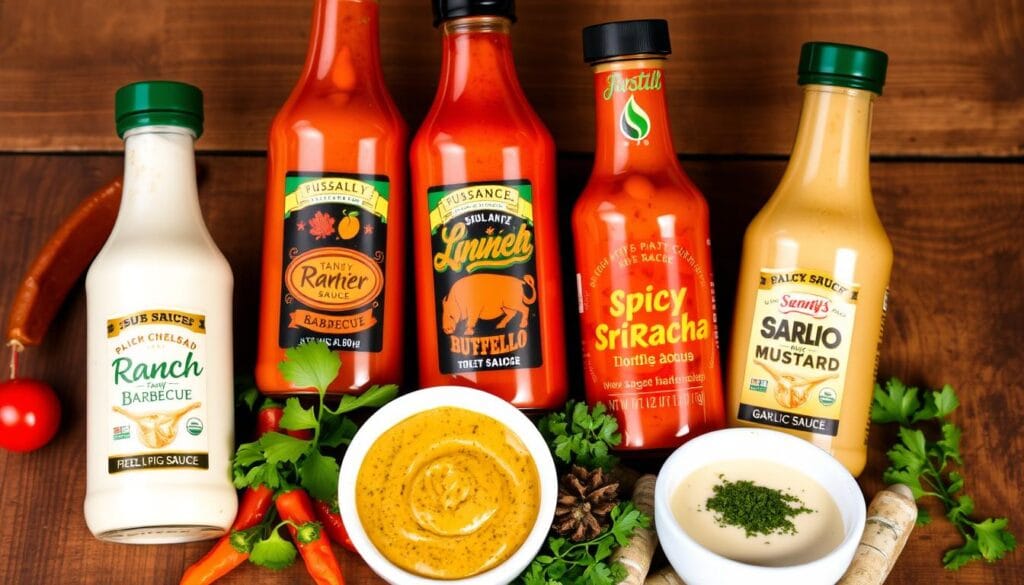Craving a tasty submarine sandwich? The secret is often the sub sauce. This sauce turns a simple sandwich into a feast. Knowing what’s in sub sauce can make your sandwiches even better1.
Submarine dressing is made of tangy and aromatic ingredients. A classic recipe includes red wine vinegar, Dijon mustard, and dried Italian seasoning1. Olive oil is the base, adding a smooth and rich texture1.
Ingredients for sub sauce can change based on where you are and what you like. Some recipes suggest using 2 teaspoons each of red wine vinegar, Dijon mustard, and dried Italian seasoning for the perfect flavor1. The trick is to make it your own1.
Pro tip: Add your sub sauce to the sandwich just before eating. This keeps the bread from getting soggy and ensures the flavors are at their best1. You can also double the recipe and store it in a fridge jar for later1.
Whether you’re making an Italian-style sandwich or trying something new, the right sub sauce is key1.
Understanding the Classic Sub Sauce Tradition
The world of sandwich sauces is filled with history, especially with Italian submarine dressing. Your favorite sub sauce has deep roots in American food culture. It blends flavors that turn simple sandwiches into amazing meals2.
Origins of Italian Submarine Dressing
Italian submarine dressing started as a way to make sandwiches taste better. It comes from Mediterranean cooking, where garlic and strong flavors are key2. The sauce was created to add depth and excitement to simple sandwiches.
The Role of Sub Sauce in Sandwich Making
Your sub sauce does more than just add moisture. It:
- Enhances the flavor of the sandwich
- Keeps the bread and ingredients moist
- Brings everything together
- Gives the sandwich a unique taste
Regional Variations Across America
Sub sauce recipes vary a lot across different regions. Each area adds its own twist to the tradition, showing local tastes and influences3. You’ll find everything from tangy vinaigrettes to creamy herb blends.
“A great sub sauce transforms an ordinary sandwich into a memorable meal.”
Whether making your own sub dressing or trying different regional versions, knowing the sauce’s history can improve your sandwich-making skills.
What is Sub Sauce Made of?
Making the perfect sub sauce is like an art. It mixes simple ingredients to make a tasty dressing for sandwiches. Knowing what goes into sub sauce can make your sandwiches better and please your taste buds.
Essential Base Ingredients
The base of most sub sauces includes oils and vinegars. Your basic sub sauce has:
- Olive oil as the main oil
- Red wine vinegar for a tangy taste
- Dijon mustard for extra flavor
Common Herbs and Seasonings
Herbs and seasonings make submarine oil special. They turn a simple dressing into a feast for the taste buds4. Key seasonings are:
- Dried Italian seasoning
- Oregano
- Basil
- Garlic powder
- Onion powder
Oil and Vinegar Components
The magic of oil and vinegar in sandwiches is their balance. When making your sub sauce, use these amounts5:
| Ingredient | Quantity | Purpose |
|---|---|---|
| Olive Oil | 1/4 cup | Base and richness |
| White Vinegar | 3 Tbsp | Tanginess |
| Sugar | 1/2 cup | Balance and sweetness |
| Cornstarch | 1 1/2 tsp | Thickening agent |

“The secret to a great sub sauce is balancing flavors and using fresh, quality ingredients.” – Sandwich Artisan
Professional tip: Try different sub sauce ingredients to find your favorite mix. Feel free to change the amounts and herbs to match your taste!
The Perfect Oil and Vinegar Ratio for Sub Sauce
Creating the perfect sub dressing starts with the right oil and vinegar mix. Chefs and home cooks agree on a classic ratio6. The standard mix is 3 parts oil to 1 part vinegar, making a tasty dressing for subs7.
For subs, extra virgin olive oil is the top choice. It adds great taste and health benefits to your sauce6. Some suggest making fresh dressing each time to keep the oil’s quality and avoid texture problems from fridge storage6.
Customizing Your Sub Sauce Ratio
You can tweak the 3:1 ratio to suit your taste:
- Classic 3:1 ratio (3/4 cup oil to 1/4 cup vinegar)6
- More acidic option: 3:5 ratio of vinegar to oil6
- Balsamic twist: 1:1 ratio of balsamic to sherry vinegar6
Essential Ingredients for Sub Sauce
| Oil Options | Vinegar Varieties | Additional Flavors |
|---|---|---|
| Extra Virgin Olive Oil | Red Wine Vinegar | Dijon Mustard |
| Vegetable Oil | White Wine Vinegar | Honey |
| Canola Oil | Balsamic Vinegar | Garlic Powder |
Try out different mixes to create your ideal sub sauce. The goal is to balance flavors and keep the right oil and vinegar ratio6.
Creating the Base: Mayo and Ranch Variations
Starting with the right sub sauce base is key. It can change how you enjoy your sandwich. Choosing between mayo and ranch is important for flavor.

Exploring Creamy Foundations
For a mayo-based sub sauce, use top-notch ingredients. The basic mix includes:
Flavor Enhancement Techniques
To make your dressing better, add these ingredients:
| Sauce Type | Key Characteristics | Best Used With |
|---|---|---|
| Mayo-based Sub Sauce | Rich, smooth texture | Cold cut sandwiches |
| Ranch-based Sub Sauce | Tangy, herbal flavor | Grilled chicken sandwiches |
Pro tip: Always taste and adjust your ranch-based sub sauce to match your personal preference8.
When trying new sauces, chill them for 30 minutes to blend flavors9. Your homemade sauce can last up to 10 days in the fridge9.
Nutritional Insights
A 2-tablespoon serving of creamy sub sauce has:10
• 127 calories
• 13g total fat
• 1g carbohydrates
Essential Herbs and Spices in Sub Sauce

Making the perfect sub sauce is all about the right mix of herbs and spices. These ingredients turn a simple sandwich into a feast for the taste buds. Your homemade sub sauce herbs are key to creating deep, rich flavors that make every bite special.
Most Italian sandwich dressing spices start with a classic blend of dried herbs. These add a true taste and depth to your sauce. Here are the must-have seasonings:
- Dried oregano
- Basil
- Thyme
- Rosemary
- Garlic powder
- Onion powder
- Black pepper
Professional chefs say to play with different sub sauce seasonings to find your perfect flavor. Adding fresh herbs like parsley or cilantro can bring a burst of color and taste. For a spicy kick, red pepper flakes are a great choice11.
“The secret to an amazing sub sauce is balancing your herbs and spices with precision and creativity.”
When making your dressing, pay attention to the oil and vinegar mix. Jersey Mike’s, a famous sandwich place, uses olive oil and red wine vinegar in a 3:2 ratio. This gives their dressing a unique taste12.
| Herb Category | Flavor Profile | Recommended Quantity |
|---|---|---|
| Dried Italian Herbs | Robust and Earthy | 1-2 teaspoons |
| Fresh Herbs | Bright and Crisp | 1-3 tablespoons |
| Spicy Additions | Warm and Intense | 1/4-1/2 teaspoon |
Pro tip: Always taste and adjust your herbs and spices to suit your personal preference. The beauty of homemade sub sauce lies in its versatility!
Popular Sub Sauce Variations and Styles
Exploring sub sauce variations opens up a world of flavors. You can go from classic Italian dressings to zesty Southwest sauces. Each one adds a special twist to your sandwiches13.

Italian-Style Sub Dressing
Italian sub dressing is a timeless choice. It combines herbs like oregano and basil for a rich taste. This style celebrates the flavors of the Mediterranean14.
- Rich herb blend
- Olive oil base
- Parmesan-inspired notes
Southwest Chipotle Sauce
For a spicy kick, try Southwest chipotle sauce. It uses smoky chipotle peppers for a bold flavor. The mix of ranch, mayo, and spices makes it unforgettable13.
“A good Southwest chipotle sauce should dance between smoky, spicy, and creamy” – Culinary Expert
Classic Vinaigrette Style
The classic vinaigrette is light and tangy. It’s made with oil, vinegar, and sometimes Dijon mustard. It’s great for a refreshing, less creamy taste15.
| Sauce Type | Key Characteristics | Flavor Profile |
|---|---|---|
| Italian | Herb-forward | Mediterranean |
| Southwest Chipotle | Spicy and smoky | Bold and zesty |
| Vinaigrette | Light and tangy | Refreshing |
Pro tip: Experiment with these sub sauce variations to find your perfect sandwich companion!
Making Your Own Homemade Sub Sauce
Making a DIY sandwich dressing at home is simple. A homemade sub sauce recipe lets you pick your flavors and ingredients. With just a few basic parts, you can make a tasty sauce that makes your sandwiches special16.
- Gather fresh ingredients
- Measure carefully
- Whisk with precision
The key ingredients for a classic homemade sub sauce are:
| Ingredient | Quantity |
|---|---|
| Soybean oil | 4 cups |
| Olive oil | 1 cup |
| Hot pepper juice | 1 1/2 cups |
| Oregano | 1 teaspoon |
| Garlic | 1 teaspoon |
Pro tip: Emulsify your sauce by whisking slowly and thoroughly. If it separates, just shake it again to mix it back16. Your homemade sub sauce can last up to two weeks in the fridge if stored in an airtight container16.
“The secret to a great sub sauce is fresh ingredients and careful preparation.”
Your homemade sauce is pretty light, with about 19 calories per serving. It has 2g of fat and no carbs or protein16. Try adding different herbs or spices to make it your own!
Storage Tips and Shelf Life
Storing sub sauce right is key to keeping its taste and preventing it from going bad. Knowing how to store your homemade dressing lets you enjoy your sandwich sauce for longer17.
Choosing the Right Container
Choosing the right container is important for keeping your sandwich sauce fresh. Here are some tips:
- Use airtight glass containers for the best preservation
- Mason jars are great for storing sub sauces
- Food-grade plastic containers are also a good choice
Temperature and Preservation Guidelines
Keeping the right temperature is key for your homemade dressing’s shelf life18:
- Keep the sub sauces refrigerated below 40°F (4°C)
- Oil-based sauces can last up to two weeks in the fridge
- Creamy sauces should be used within one week
Shelf Life and Storage Tips
Different sub sauces need different storage methods17:
- Keep storage areas cool, dark, and dry
- The best temperature range is 50-70°F
- Always check for signs of spoilage before eating
Pro tip: Label your container with the preparation date to track freshness!
Freezing can make your sub sauce last longer, but it might change a bit when thawed17. Always trust your senses. If the sauce smells bad or looks off, it’s best to throw it away.
Common Mistakes to Avoid When Making Sub Sauce
Making the perfect sub sauces needs careful attention. Many home cooks make mistakes that ruin the flavor. Knowing these mistakes can improve your cooking skills.
Here are some tips to avoid mistakes when making homemade dressing:
- Avoid using low-quality ingredients that compromise taste19
- Prevent over-seasoning which masks delicate flavors
- Ensure proper emulsification of oil and vinegar
Choosing the right ingredients is key. Fresh herbs and high-quality oils make a big difference19. Watch how much salt and vinegar you use, as they can overpower other flavors.
“The difference between a good sauce and a great sauce is in the details.” – Culinary Expert
Mixing techniques are important. When mixing, add oil slowly to vinegar while whisking. This keeps the sauce smooth and prevents it from separating.
- Refrigerate immediately after preparation
- Check ingredient expiration dates
- Taste and adjust seasonings gradually
By avoiding these mistakes, you’ll make a tasty sub sauce. Remember, practice and patience are essential for making great homemade dressing19.
Conclusion
Making the perfect sub sauce is like turning a simple sandwich into a work of art. It’s not just about adding flavor. It’s about controlling every ingredient and taste20. You can choose from creamy or oil-based dressings, making your condiment unique.
Learning how to make sub sauces opens up a world of possibilities. You can play with herbs, spices, and bases. The goal is to find the perfect mix that goes well with your favorite sandwich toppings. Just like traditional sauces have evolved over time20, your sub sauces can become a special recipe that makes every sandwich better.
Creating great sandwich dressing is all about knowing how ingredients work together. Use top-notch oils, fresh herbs, and the right seasonings. This way, your sauce will show off your cooking skills. With dedication, you’ll make sandwiches that taste like they came from a restaurant.
Start your sauce-making adventure and don’t be shy to try new things. With time, you’ll make a sub sauce that you’ll love making and eating. It will become a favorite part of your cooking routine.